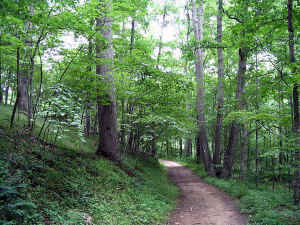Greetings, fellow ENTS!
Well, Friday was the last day for at least a week or two here in
Maryland that we would get to enjoy reasonable high temperatures
- for
me, that's under 80 if I am lucky! So, I took the day off from
work and
headed to the northern end of Patapsco State Park, which is a
new place
for me to visit since I normally haunt the southern end (the
Avalon,
Orange Grove, etc. area)
The northern area of the park is about 20 miles WNW of the
southern end,
and about 200 feet higher in average elevation (400 feet vs. 200
feet).
This may not seem like a huge change in climate, but the forest
composition is dramatically different. The park is far more
hilly than
the areas closer to Baltimore and the Bay, hinting at the
eastern
ramparts of the Appalachian Mountains that only lie about 30 to
40 miles
to the west.

Picnic with Giants
There are very few sycamores and beech trees in this region, and
while
tulip trees still reach great size, they are less common than in
the
southern regions of the park. The dominant trees in the McKeldin
area
are oaks of various kinds, chestnut oak and northern red oak in
particular, and hickories of many varieties. There were also a
good
number of black gum trees in the area, and various oak trees of
types
that I could not immediately recognize. Finally, the northern
area of
the park had a much higher number of conifers than the southern
area.
White pine was the dominant conifer, though I am not sure if it
was all
naturalized trees or if some of them were planted in one area.

Trail Chestnut Oaks
What is particularly interesting to me is that the dominant
oak-hickory
forest type reminds me a lot more of the forest I've seen at
Downs
Memorial Park, which is right on the waters of the Chesapeake
Bay, than
the forests of the southern regions of Patapsco State Park. I am
not
sure why this is the case, except perhaps for soil composition
or some
other factor. Or, perhaps the southern areas of Patapsco are
actually
unusual in their heavy populations of sycamores and tulip trees.
At any rate, I didn't bring any measuring equipment with me, but
the
largest trees in the McKeldin area are surely the tulip trees,
and they
reach sizes about the same as what one can find in the southern
regions.
The next largest trees are probably either the few scattered
sycamores
or some of the biggest chestnut oaks that reached rather
respectable
girths (3+ feet, estimating). The trees in general are not as
tall here,
probably because of the higher elevation, more wind and storms,
etc.
Anyway, I figured my fellow ENTS would enjoy another report from
Maryland and this one offers an interesting example of how a
seemingly
modest change in environment between two areas can produce a
dramatically different forest composition.
|